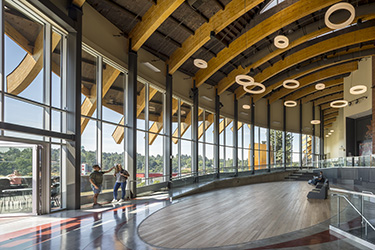|
Subscribe / Renew |
|
|
Contact Us |
|
| ► Subscribe to our Free Weekly Newsletter | |
| home | Welcome, sign in or click here to subscribe. | login |
Architecture & Engineering
| |
 |
October 26, 2017
WSU cultural center: ‘How are you going to build this?’
PCS Structural Solutions

Heath |
Elson S. Floyd Cultural Center, named in memoriam for the late visionary president of Washington State University, stands at the campus entrance as a statement of inclusion. It celebrates four underrepresented people groups while creating an environment that melds with the surrounding hills of the Palouse.
This building represents so much to so many. Its legacy is far more than the free-form roof. As an alum, this project was special — part homecoming and part awe. What struck home for all of us on the design team was the passing of Dr. Floyd during the design-build selection process.
As a design team, GGLO, Absher Construction Co. and PCS Structural Solutions came together to honor his vision by creating a cultural center where there are no boundaries and where all are welcome.
I realized that this team and design were unique from the outset. The lessons learned are applicable to so much more than just this two-year journey. Let me share a few of the things we discovered along the way.
Believe in the process
During the design competition phase, we had three proprietary meetings with the owner and competed against two other design-build teams. The bridging documents for the competition gave minimum programming requirements and stated very clearly that the building needed to be iconic.
At our initial meeting with WSU, we began a dialogue focused on understanding the environment and the culture that this building would bring to the campus. We conducted pedestrian, day lighting and massing studies to identify and address design concerns. Our approach was slower, but our aim was to partner and share that vision together.
We presented our actual design concept at the second proprietary meeting. The owner requested we reconsider our approach and truly push the design envelope to deliver a more unique, standout building. With new direction, we turned on the creative juices.
Presenting our final and winning idea in the last meeting reaffirmed our partnering philosophy. We learned having the restraint to stop and listen was just as important as executing our concept. We never got so far ahead that we didn’t have followers. We took our time, developed our ideas and believed in the process.
The extra mile
After the project was awarded, the contractor and the architect looked at me and asked, “How are you going to build this?”
No pressure, right?
Rectilinear building concepts are easy to grasp. Free-form and curved building geometries are difficult subject matters to verbally convey. Rather trying to explain while my team members’ eyes glazed over, I used the one resource common to the people of Seattle: coffee cups and stir sticks. Piecing these members together like Tinkertoys, I was able to use a couple of quick models to illustrate how straight members would interact on curved surfaces — ensuring that everyone was on the same page and understood the issues at hand.
The extra mile only cost me a latte, but the ability to tangibly convey a concept was priceless. Effective communication is paramount for any project to succeed.
Provide options
During the design, we ended up brainstorming about five different options for a singular beam connection that was to be repeated 25 times at a concrete wall. It was a significant design decision, as labor and material costs were involved. We showed the contractor and the architect all of the options, along with the pros and cons for each. The team ended up using an adaptable bearing seat connection that saved on field labor and crane erection time.
The chosen connection wasn’t the cheapest option, but it eliminated a lot of error in the field. In fact, we didn’t have a single missed connection due to all of the pre-planning.
As consumers, we all like to have a palette to choose from. We all have preferences on how to do things, but getting buyoff by the end user validates the design process. Facilitating dialogue and providing options is the key to success.
Don’t assume anything
Our roof glulam beams had a constant radius of 86 feet, 3 inches — which meant every 8 feet the roof slope changed 2 inches.
Early in the design process, we were looking for ways to simplify our roof assembly to speed up erection times. Initially, we thought 1-1/8-inch plywood sheathing could bend the required 2 inches to fit the curve of the roof. Nobody knew for sure, so we recommended that the contractor go to its lumber supplier to test if the sheathing could bend. We learned that our hypothesis was wrong and that we needed to use two smaller layers of sheathing to support the roof.
In the words of Russell Wilson: “The separation is in the preparation.”
Spending a little extra time to validate your ideas before you execute will make your endeavor go much more smoothly. Glossing over details and making assumptions is a recipe for disaster. When you are out of your comfort zone, it is better to ask questions early on rather than being questioned later when problems arise.
Communicating expectations
Our roof geometry required us to think creatively. Knowing that this project was radically different from rectilinear projects, we initiated a lot of the coordination items early in the design process. We needed to know the parameters to work by and have buyoff from all the stakeholders. This included the glulam manufacturer, steel detailers and erectors, and drywallers, to name a few. They were signed to contracts early to solicit their input and to guarantee their price so that the project could move forward.
Ultimately, we produced drawings and a model that was responsive to their needs, consistent with their price and buildable. In fact, the contractor ended up using the model in conjunction with its surveying equipment to set all of the curved concrete wall heights.
Was the project perfect? No. Was there room for improvement? Yes. However, when we walked the construction site with a subcontractor we had sat at the table with during the design development phase, we knew that this project would be well executed. Our team’s success was in direct correlation to its initial philosophy of having open dialogue with all parties to meet their needs and expectations.
This fall, the 16,000-square-foot, $12 million Elson S. Floyd Cultural Center opened its doors as a testament that visions can be made reality and ingenuity can prosper in a design-build competition.
Luke Heath is a structural engineer and principal at the new PCS Portland office, and has been in the industry since graduating from WSU in 2002. PCS is a structural engineering firm with offices in Seattle, Tacoma and Portland. It has partnered with design-build teams on over 10 educational facilities across Washington, including the Elson S. Floyd Cultural Center.
Other Stories:
- Ice Box Challenge: a cool test of Passive House
- Survey: Code Unlimited
- Survey: IA Interior Architects
- Surveys: NAC Architecture
- Survey: AHBL
- Survey: Lemons Architecture
- Is growth only benefiting a small segment in Seattle?
- Rock wool’s new role: protecting exterior wood stud walls
- Get ready for the new year — and new energy codes
- After 10-year engagement, Kinects inverts ‘wedding cake’
- High-performance building? Start with early design analysis
- How ‘affordable’ housing is disappearing in Seattle
- How long will your AV last? Consider your cell phone
- Survey: Arup



